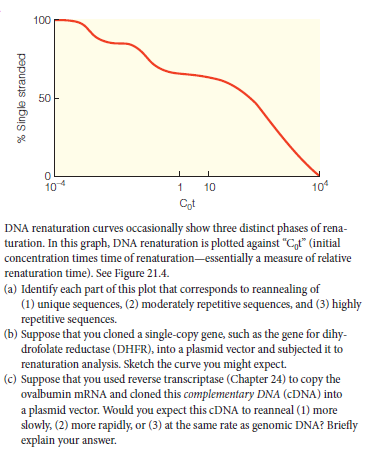100 50 10 1 10 10 Cot DNA renaturation curves occasionally show three distinct phases of rena- turation. In this graph, DNA renaturation is plotted against "Cf" (initial concentration times time of renaturation-essentially a measure of relative renaturation time). See Figure 21.4. (a) Identify each part of this plot that corresponds to reannealing of (1) unique sequences, (2) moderately repetitive sequences, and (3) highly repetitive sequences. (b) Suppose that you cloned a single-copy gene, such as the gene for dihy- drofolate reductase (DHFR), into a plasmid vector and subjected it to renaturation analysis. Sketch the curve you might expect. (c) Suppose that you used reverse transcriptase (Chapter 24) to copy the ovalbumin mRNA and cloned this complementary DNA (CDNA) into a plasmid vector. Would you expect this CDNA to reanneal (1) more slowly. (2) more rapidly, or (3) at the same rate as genomic DNA? Briefly explain your answer. % Single stranded
100 50 10 1 10 10 Cot DNA renaturation curves occasionally show three distinct phases of rena- turation. In this graph, DNA renaturation is plotted against "Cf" (initial concentration times time of renaturation-essentially a measure of relative renaturation time). See Figure 21.4. (a) Identify each part of this plot that corresponds to reannealing of (1) unique sequences, (2) moderately repetitive sequences, and (3) highly repetitive sequences. (b) Suppose that you cloned a single-copy gene, such as the gene for dihy- drofolate reductase (DHFR), into a plasmid vector and subjected it to renaturation analysis. Sketch the curve you might expect. (c) Suppose that you used reverse transcriptase (Chapter 24) to copy the ovalbumin mRNA and cloned this complementary DNA (CDNA) into a plasmid vector. Would you expect this CDNA to reanneal (1) more slowly. (2) more rapidly, or (3) at the same rate as genomic DNA? Briefly explain your answer. % Single stranded
Biochemistry
6th Edition
ISBN:9781305577206
Author:Reginald H. Garrett, Charles M. Grisham
Publisher:Reginald H. Garrett, Charles M. Grisham
Chapter28: Dna Metabolism: Replication, Recombination, And Repair
Section: Chapter Questions
Problem 10P: Homologous Recombination, Heteroduplex DNA, and Mismatch Repair Homologous recombination in E. coli...
Related questions
Question

Transcribed Image Text:100
50
10
1
10
10
Cot
DNA renaturation curves occasionally show three distinct phases of rena-
turation. In this graph, DNA renaturation is plotted against "Cf" (initial
concentration times time of renaturation-essentially a measure of relative
renaturation time). See Figure 21.4.
(a) Identify each part of this plot that corresponds to reannealing of
(1) unique sequences, (2) moderately repetitive sequences, and (3) highly
repetitive sequences.
(b) Suppose that you cloned a single-copy gene, such as the gene for dihy-
drofolate reductase (DHFR), into a plasmid vector and subjected it to
renaturation analysis. Sketch the curve you might expect.
(c) Suppose that you used reverse transcriptase (Chapter 24) to copy the
ovalbumin mRNA and cloned this complementary DNA (CDNA) into
a plasmid vector. Would you expect this CDNA to reanneal (1) more
slowly. (2) more rapidly, or (3) at the same rate as genomic DNA? Briefly
explain your answer.
% Single stranded
Expert Solution
This question has been solved!
Explore an expertly crafted, step-by-step solution for a thorough understanding of key concepts.
This is a popular solution!
Trending now
This is a popular solution!
Step by step
Solved in 2 steps

Recommended textbooks for you

Biochemistry
Biochemistry
ISBN:
9781305577206
Author:
Reginald H. Garrett, Charles M. Grisham
Publisher:
Cengage Learning

Biochemistry
Biochemistry
ISBN:
9781305577206
Author:
Reginald H. Garrett, Charles M. Grisham
Publisher:
Cengage Learning